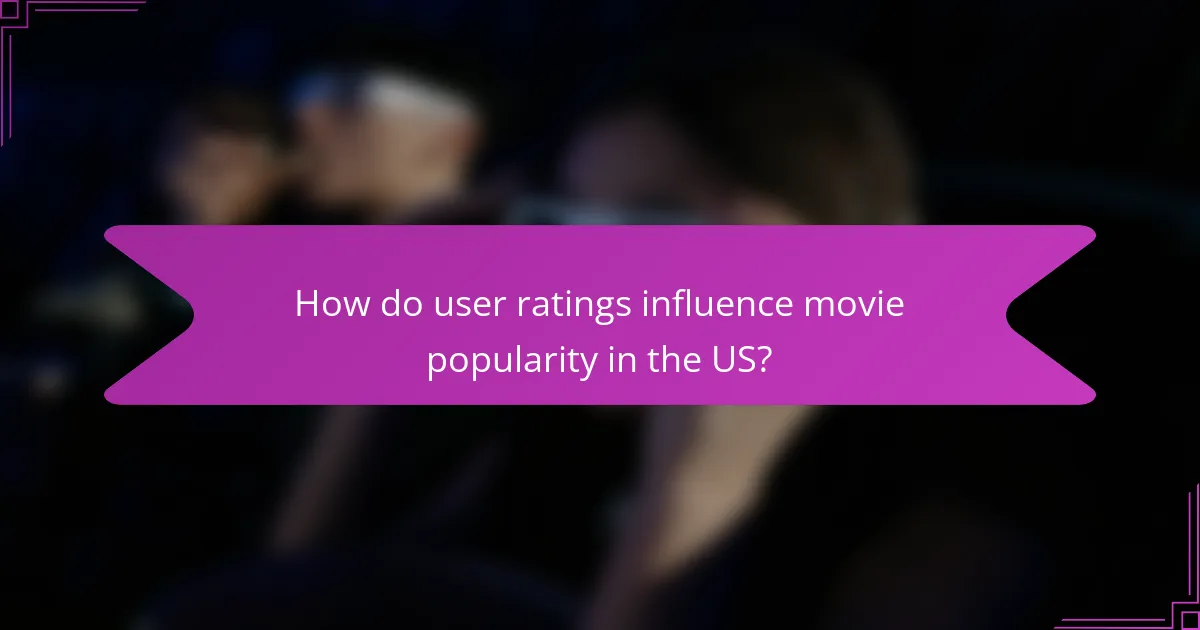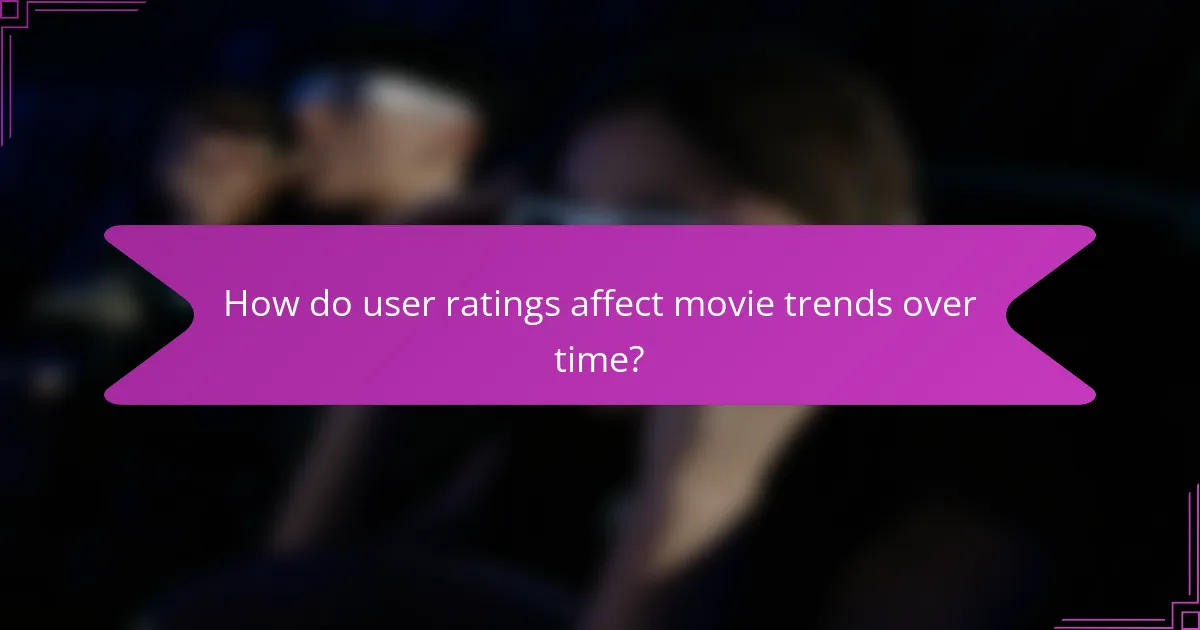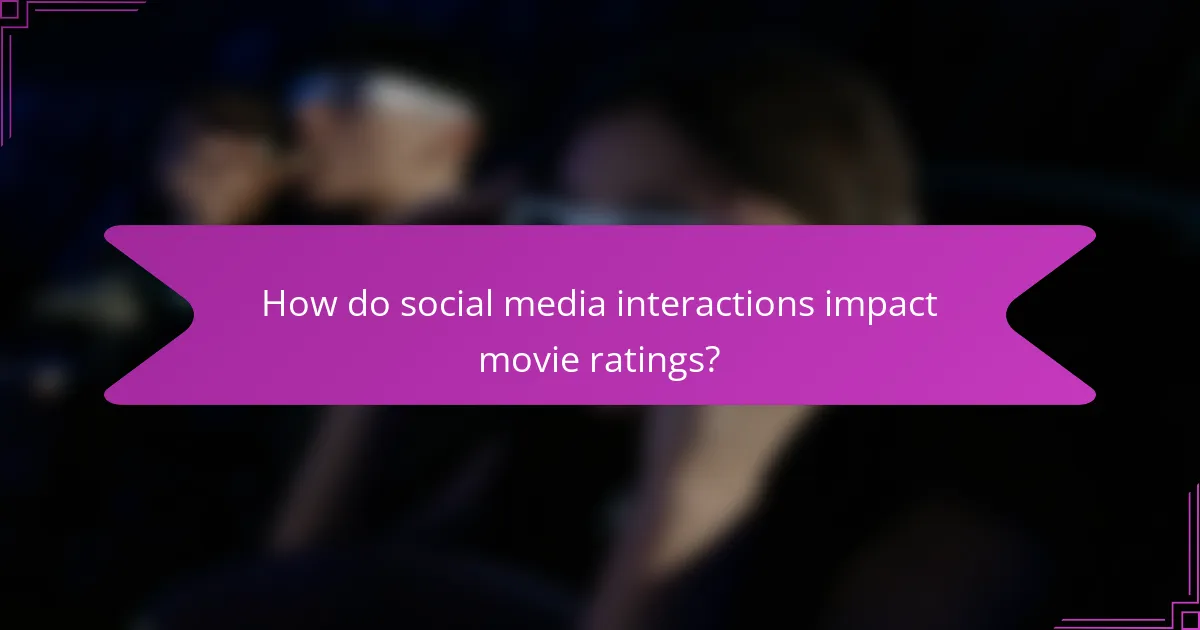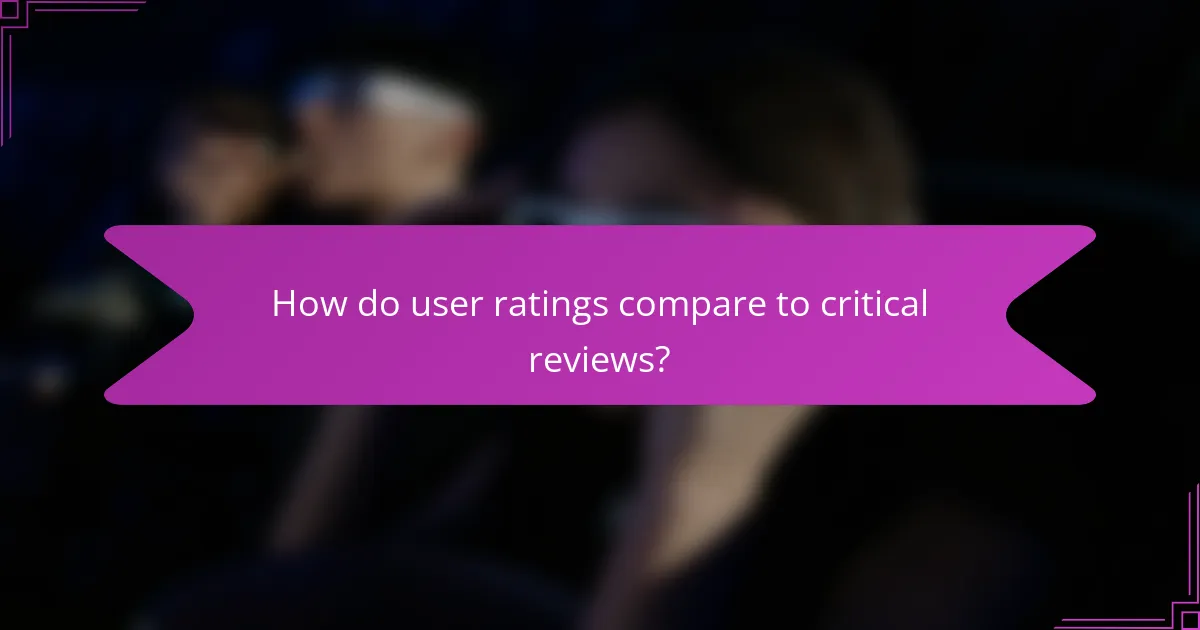User ratings play a crucial role in determining movie popularity, particularly in the US, as they shape audience perceptions and drive box office success. Platforms like Rotten Tomatoes aggregate these ratings, influencing viewer decisions and highlighting trends in audience preferences over time. As ratings evolve, they can shift the popularity of films and genres, guiding both viewers and industry professionals alike.

How do user ratings influence movie popularity in the US?
User ratings significantly impact movie popularity in the US by shaping audience perceptions and influencing box office performance. Higher ratings often lead to increased viewership, as potential moviegoers tend to trust the opinions of their peers over traditional advertising.
Higher ratings correlate with increased box office revenue
Movies that receive higher user ratings typically see a direct correlation with their box office revenue. For instance, films rated above 80% on popular platforms like Rotten Tomatoes often gross significantly more than those rated below 50%. This trend illustrates how positive user feedback can drive ticket sales.
Studios often monitor user ratings closely, adjusting marketing strategies based on audience reception. A film that garners strong ratings shortly after release may benefit from increased promotional efforts, further boosting its financial success.
Positive ratings enhance audience engagement
Positive user ratings not only attract more viewers but also enhance overall audience engagement. Films with favorable ratings tend to generate more discussions on social media and online forums, creating a buzz that can sustain interest long after the initial release.
Engagement can also lead to increased merchandise sales and streaming subscriptions. For example, a highly-rated film may prompt fans to purchase related products or seek out sequels, contributing to the franchise’s longevity and profitability.

What role do platforms like Rotten Tomatoes play in movie ratings?
Platforms like Rotten Tomatoes aggregate movie ratings from both critics and audiences, significantly influencing public perception and viewer choices. These ratings serve as a quick reference for potential viewers, often swaying their decisions on whether to watch a film.
Aggregated scores impact viewer decisions
Aggregated scores from Rotten Tomatoes can heavily influence viewer decisions, as many people rely on these ratings to gauge a film’s quality. A high score, often above 70%, can attract more viewers, while a low score may deter them. For instance, a movie with a 90% rating is generally perceived as a must-see, while one with a score below 50% might be avoided.
Viewers often check these scores before making plans to watch a movie, especially in competitive markets. This trend highlights the importance of maintaining a positive rating, as even a few negative reviews can significantly impact overall scores and, consequently, box office performance.
Critics’ consensus affects public perception
The critics’ consensus on Rotten Tomatoes can shape public perception by providing a summary of professional opinions. A well-articulated consensus can highlight a film’s strengths and weaknesses, guiding viewers in their decision-making process. For example, if critics praise a film’s storytelling but criticize its pacing, potential viewers may weigh these factors differently based on their preferences.
Moreover, films that receive a “Certified Fresh” status, indicating a high percentage of positive reviews, often attract more attention and credibility. This status can lead to increased ticket sales and a stronger cultural footprint, as audiences tend to trust the aggregated insights of critics over individual opinions.

How do user ratings affect movie trends over time?
User ratings significantly impact movie trends by reflecting audience opinions and preferences, which can shift over time. As ratings change, they can influence the popularity of certain films and genres, guiding both viewers and industry professionals in their choices.
Shifts in ratings indicate changing audience preferences
Changes in user ratings often signal evolving audience tastes. For instance, a film that initially receives high ratings may see a decline as newer releases capture viewers’ attention, indicating a shift in what people enjoy. This can lead to a reevaluation of older films, as audiences may rediscover them or critique them differently over time.
Monitoring these shifts can help filmmakers and studios identify trends, allowing them to adapt their content to better align with current viewer interests. For example, if a particular genre sees a rise in ratings, studios might invest more in similar projects to capitalize on this trend.
Ratings influence genre popularity
User ratings play a crucial role in determining which film genres gain traction in the market. High ratings for a specific genre, such as horror or romantic comedies, can lead to an influx of similar films being produced, as studios aim to replicate successful formulas. Conversely, genres that receive lower ratings may see a decline in new releases, as they become less appealing to both creators and audiences.
For example, if action films consistently receive high ratings, this genre may dominate box office sales, prompting studios to prioritize action-packed narratives. Understanding these dynamics can help audiences make informed viewing choices and allow industry professionals to strategize effectively.

What are the key factors that affect user ratings?
User ratings are influenced by several key factors, including viewer demographics, release timing, and the overall quality of the film. Understanding these elements can help filmmakers and marketers predict audience reception and adjust their strategies accordingly.
Viewer demographics impact rating patterns
Viewer demographics, such as age, gender, and cultural background, significantly shape rating patterns. For instance, younger audiences may rate action-packed films higher, while older viewers might prefer character-driven narratives. This variance can lead to notable differences in ratings across different demographic groups.
Marketers should analyze demographic data to tailor promotional strategies. For example, targeting younger audiences through social media platforms may enhance engagement for specific genres. Additionally, understanding the preferences of different demographics can help in selecting appropriate release dates and marketing messages.
Release timing affects audience reception
The timing of a movie’s release can greatly influence its ratings. Films released during peak seasons, such as summer or holiday periods, often receive more attention and higher ratings due to increased audience availability. Conversely, films released during less favorable times may struggle to gain traction.
Strategically planning a release date can maximize exposure. For example, avoiding competition from blockbuster films can enhance a movie’s visibility. Additionally, considering cultural events or holidays that resonate with the target audience can further improve reception and ratings.

How do social media interactions impact movie ratings?
Social media interactions significantly influence movie ratings by shaping public perception and driving viewer engagement. Positive discussions and shares can enhance a film’s visibility, leading to increased ratings and popularity.
Viral trends can boost ratings
When a movie becomes part of a viral trend on platforms like TikTok or Twitter, it often sees a surge in ratings. These trends can create a buzz that attracts viewers who might not have considered watching the film otherwise.
For example, a catchy scene or memorable quote can be shared widely, prompting audiences to check out the movie. This phenomenon can lead to a rapid increase in ratings, sometimes within days of the trend’s inception.
Influencer endorsements shape audience opinions
Influencers play a crucial role in shaping audience opinions about movies. When popular figures endorse a film, their followers are more likely to trust their judgment and watch the movie, which can positively impact ratings.
For instance, a well-known influencer sharing their excitement about a new release can lead to a significant uptick in viewership and ratings. Brands often collaborate with influencers to promote films, leveraging their reach to maximize audience engagement.

What are the limitations of user ratings in evaluating movies?
User ratings can provide insights into movie popularity, but they have significant limitations that can misrepresent a film’s true quality. Factors such as personal biases and manipulation can lead to skewed perceptions, making it essential to consider these ratings critically.
Subjectivity of ratings can skew perceptions
The subjective nature of user ratings means that individual preferences heavily influence scores. For instance, a movie that appeals to a niche audience may receive high ratings from a small group while being rated poorly by the general public. This disparity can create a misleading overall impression of the film’s quality.
Moreover, cultural differences can affect how viewers rate films. A comedy that resonates well in one country may not translate the same way in another, leading to varied ratings that do not accurately reflect the movie’s universal appeal.
Fake reviews can distort actual popularity
Fake reviews, whether positive or negative, can significantly distort a movie’s perceived popularity. Some companies may resort to generating false ratings to boost their films or undermine competitors, creating an unreliable landscape for potential viewers. This manipulation can mislead audiences about a film’s actual reception.
To navigate this issue, it’s advisable to look for verified reviews from reputable sources or platforms that employ measures to filter out fraudulent ratings. Checking for patterns in reviews, such as an unusual number of high scores within a short time frame, can also help identify potential fake reviews.

How do user ratings compare to critical reviews?
User ratings often reflect the general audience’s enjoyment of a film, while critical reviews provide a more analytical perspective. Typically, user ratings can vary significantly from critic scores, highlighting differing opinions on what makes a movie successful or enjoyable.
User ratings often differ from critic scores
User ratings can frequently diverge from critic scores, as they are influenced by personal preferences and emotional responses rather than technical analysis. For instance, a blockbuster film might receive a low critic score due to its lack of depth but still achieve high user ratings because of its entertainment value.
This discrepancy can be seen in various films where audience scores on platforms like Rotten Tomatoes or IMDb are significantly higher than those given by professional critics. Such differences can range from a few percentage points to over twenty points, reflecting the subjective nature of film appreciation.
Audience tastes can diverge from critical consensus
Audience tastes often diverge from critical consensus due to varying expectations and experiences. While critics may prioritize storytelling, cinematography, or originality, general viewers might focus on entertainment, nostalgia, or star power. This can lead to films that resonate well with audiences but are panned by critics.
For example, a romantic comedy may be criticized for its formulaic plot but still attract a loyal fan base, resulting in a high user rating. Understanding these differences can help filmmakers and marketers tailor their strategies to better align with audience preferences while also considering critical feedback.

What emerging trends are shaping user ratings in the film industry?
Emerging trends in user ratings are increasingly influenced by technology, social media, and changing audience behaviors. These factors are reshaping how films are rated and perceived, impacting their popularity significantly.
Increased reliance on AI for rating analysis
The film industry is seeing a growing dependence on artificial intelligence (AI) to analyze user ratings. AI algorithms can process vast amounts of data from various platforms, identifying patterns and trends that human analysts might miss. This technology helps studios understand audience preferences and predict box office performance more accurately.
AI tools can evaluate sentiment from user reviews, social media comments, and rating scores, providing insights into how different demographics perceive a film. For instance, a movie that receives high ratings from younger audiences may indicate a trend toward themes that resonate with that age group, guiding future productions.
However, studios should be cautious about over-relying on AI. While it offers valuable insights, human judgment remains essential in interpreting data and making creative decisions. Balancing AI analysis with traditional audience feedback can lead to more successful film strategies.



